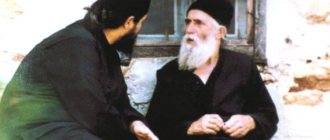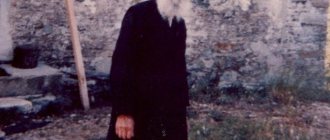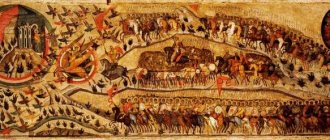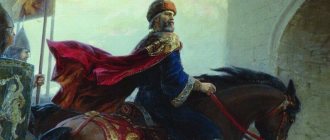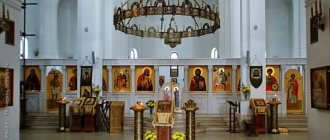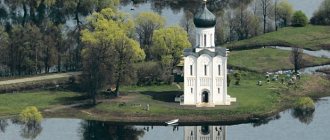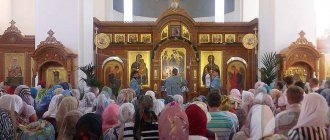Saint Paisios is one of the most respected and revered elders of the Greek people in the 20th century. The Elder of Mount Athos is known to many for his spiritual instructions and righteous life.
Many memoirs and books have been written about him, and documentary video footage with the participation of the priest has been preserved. And director Alexander Stolyarov made a film about him, “Elder Paisius and Me, Standing Upside Down.”
Who is Elder Paisios
The greatest ascetic of our time, Schemamonk Paisiy Svyatogorets devoted his entire life to serving God and people. His heart was full of meekness, humility and love.
Birth and childhood
Arseniy Eznepidis, better known as Saint Paisios, was born on July 25, 1924 in the Greek village of Farasy in Turkey (eastern Cappadocia). In the same year, a population exchange took place between Greece and Turkey.
In the fall of 1924, the Eznepidis family settled in the city of Konitsa in Epirus. Saint Arseny of Cappadocia, who baptized the baby, named the boy Arseny, saying: “I want to leave behind me a monk.” In his words, he predicted the future fate of the child.
There Arseny grew up, graduated from school and received the profession of a carpenter.
Family
Hadjidigenis is the surname of the elder’s ancestors passed down from generation to generation, but life decreed that the boy’s relatives were forced to take a different surname. The name of Arseny's great-grandfather, whose name was Feodosius, served as a new surname.
Being a deeply religious Christian, Arseny’s grandmother, Hadji-Christina, owned a small church of St. Michael the Archangel, which was located at a considerable distance from the village. Spending time in fasting, prayer and silence, Hadji-Christina sometimes retired to this temple.
One winter, the church was covered with snow. The woman who was inside the temple at that time could not get out. But hot bread appeared on the church windowsill every day. She prayed and accepted this Divine gift. Arseny’s grandmother also had her own house in Adana, where the boy often came.
Prodromos Theodosiou, the pope of Arsenios, was forced to change his surname again to Eznepidis, which means “foreigner” due to persecution by the Turks. The Farasiote family, to which Prodromos belonged, was distinguished by its nobility and high position in the city. She ruled in Faras for many generations. Prodromos himself worked as a headman for several decades.
Prodromos, a good craftsman and hardworking worker, was engaged in iron smelting. Having a brave and fearless heart, he saved his village many times from the Turks, who even took him prisoner once, but the prayers of the Monk Arsenios saved Prodromos from misfortune.
Remaining the headman of the Pharasiote refugees in Konitsa, the old man Prodromos left the most barren plot of land to his family when distributing plots for immigrants from Asia Minor. While clearing it, he burned out thickets of thorny bushes and injured his eyes from the fire and smoke.
Arseny's mother's name was Eulogia. She was a relative of the Monk Arsenios of Cappadocia and came from the Frangopoulos family. At the age of fifteen, Eulogia was married to Prodromos Eznepidis.
Ten children were born into their family. The first children, Catherine and Sotiria, died in infancy. At the baptism of the third child, also a girl, the Monk Arseny ordered her to be given the name Zoya, which translated means “life.” After this incident, their children did not die. The names of the children of Eulogia and Prodromos were: Zoe, Amalia, Maria, Raphael, Charalampius, Arsenios (the future Elder Paisios), Luke and Christina. Raphael and Christina are still alive.
Teenage years and early life
In 1945, young Arseny was drafted into the active army. There he served as a radio operator for three and a half years. During the war, Arseny showed extraordinary courage. A civil war broke out in Greece at that time. Arseny was unable to begin monastic life after the end of the war, as he needed to help his sisters.
Monastic life
In 1950, Arseny became a novice of confessor Kirill, who later became abbot of the Kutlumush monastery on Athos. Following the direction of Kirill, Arseny arrived at the Esphigmen monastery. In 1954, after four years of obedience, he was tonsured into the ryassophore with the name Averky and moved to the monastery of Philotheus, where he became a student of Father Simeon.
In 1956, Averky was tonsured into the minor schema with the name Paisiy. Priest Simeon performed tonsure. He was given a new name in honor of Metropolitan Paisius II of Caesarea of Cappadocia.
In 1958 he helped stop the spread of Protestant teachings in Stomio Konicka. The elder went to live at the monastery of the Nativity of the Virgin Mary in Stomio, then in 1962 he went to Sinai.
With the money he earned through hard work, Paisiy fed the Bedouins, who loved him very much. Returning to Athos in 1964, Paisiy settled in the Iveron monastery.
Gift of Prophecy and Healing
In 1966, Paisiy became seriously ill and a significant part of his lung was taken away. The elder was cared for in the hospital by sisters who wanted to found the monastery of St. John the Theologian. Schemamonk Paisiy helped them find a place for a monastery and helped them spiritually until the end of their lives.
In May 1978, Father Paisiy settled in the cell of Panaguda of the Kutlumush Monastery. Here he began to receive numerous pilgrims.
The cell "Panaguda" is located on the top of a low hill not far from the path connecting the Iveron Monastery with Karyes, opposite the monastery of St. Panteleimon. The cell’s temple was consecrated in honor of the Nativity of the Blessed Virgin Mary, which is why the cell is called “Panaguda” (“small Panagia”).
Having settled in Panaguda, the elder made sacrifices, because this place was more accessible to visitors. Pilgrims spent the night in nearby monasteries.
Taking on the burdens of people, monk Paisius began to become physically exhausted.
Creative activity
The Monk Paisius is known for his spiritual teachings, his ascetic life and valuable advice.
Among the most famous books written by the elder, the following deserve special attention:
- “The Svyatogorsk Fathers and Svyatogorsk Stories”;
- "Letters";
- “Thoughts about the Christian family”;
- "Arseny of Cappadocia";
- “Words” (five-volume edition).
The five-volume “Words” is a collection of reflections and advice from the saint, consisting of records of his teachings, conversations and letters. The material is organized, each volume is devoted to a separate problem. All volumes have been translated into many languages of the world.
“Words” are presented in a simple and convenient form - question and answer:
- Volume one - “With pain and love about modern man” - discussions about the culture of the modern world and the role of the Church in our time, about the devil and sins.
- Volume two - “Spiritual Awakening” - tells readers about difficult life situations in which each of them may find themselves. Here the elder talks about the importance of prudent behavior, working on oneself and defeating the indifference and irresponsibility of modern people.
- Volume three - “Spiritual struggle” - the theme of confession and repentance, the struggle with thoughts.
- Volume four - “Family Life” - examines the trials and issues of the family, talks about the role of husband and wife in family relationships, choosing a life path in adolescence, and raising children.
- Volume five - “Passion and Virtues” - the elder’s advice on how to recognize passions and free yourself from them by performing virtuous actions.
last years of life
In his declining years, Elder Paisius was tormented by intestinal bleeding. But when he realized that visitors had a real need for his advice, the Holy Mountain resident, despite his health, got out of bed and let the visitors in.
He did not murmur or complain about his health, performed daily monastic duties, and strictly observed the rules. Unfortunately, the monk grew weaker every day.
On October 22, 1993, Paisius left the monastery of St. John the Theologian in Suroti. For the elder, this trip was the last. He was not destined to return to the Holy Mountain.
In Suroti, the elder suffered from a volvulus and was forced to go to the hospital for examination. The old man turned out to have advanced cancer. On February 4, 1994, Paisius underwent surgery. Although the tumor in his colon was removed, the cancer progressed rapidly, affecting his lungs and liver.
The elder died in the St. John the Theologian Monastery on July 12, 1994 near Thessaloniki. The place of his burial - behind the altar of the monastery church of St. Arsenius of Cappadocia - became a real shrine for all Orthodox Christians.
On January 13, 2015, Schemamonk Paisiy was canonized by the Holy Synod of the Ecumenical Patriarchate.
Orthodox Christians celebrate the day of remembrance of St. Paisius Agiorite (Svyatogorets) on July 12.
Paisiy Svyatogorets and spiritual laws
Remember what we said above about the fact that in his case the spiritual laws “worked” almost instantly? He could not heal the kitten as long as there was a grain of insubordination in his desire. As soon as she left, the animal instantly recovered.
Being a holy elder, Paisius the Svyatogorets very subtly sensed the spiritual laws and relationships in life. There were cases when he understood that this or that disease was caused not so much by medical factors as by the sins of the person himself or his loved ones.
For example, he told one father: your child will recover, but for this you must at least quit smoking. This was not “bargaining” - the elder simply understood that many diseases are given to people as an incentive and a sign to change their lives.
Film "Elder Paisios and I, standing upside down"
One of the works of documentary director Alexander Stolyarov, which gained great popularity, was the film entitled “Elder Paisiy and I, Standing Upside Down,” which was released in 2012.
History of creation
Screenwriter A. Stolyarov had a desire to make a film about Schemamonk Paisia a long time ago. The script for the future film was written 10 years ago. Saint Paisios has recently become very popular. Many documentaries are being made about him on Russian television.
Film idea
The film is based on the stories and parables of schemamonk Paisius the Holy Mountain, which were recorded by another monk, Christodoulus Agiorite. Parables and everyday incidents became the basis for this artistic painting.
Before us is a modern saint from Mount Athos and a modern artist who stands upside down.
The first question that arises when reading the title of the painting is why upside down:
- The young monk often films Schemamonk Paisius playing upside down on camera.
- Speaking figuratively, the world of every person is imperfect and, as it were, “turned upside down,” especially now, in the era of postmodernism. And people who are changelings in life are not immune from somersaults, revolutions, spiritual and moral decline. Even the supreme apostle Peter, who renounced three times, was not even immune from it.
- The stability of any person, even a saint, is always unreliable, and in our time, when virtual reality is confidently replacing conventional reality, even more so. With his film, the author wanted to show monks and saints as people who are not alien to anything human, including humor.
The film's budget was allocated for documentary filmmaking, but the script was written as a feature film, so the director and his troupe had to constantly pray and get out of it literally at every step. However, the end result was a feature film with elements of artistic storytelling.
The film was filmed in the monastery, and the monks also took part in the filming. The film was shot for two weeks, then the director was hospitalized, but quickly “escaped” from there to the set.
The best episode, which the director is really proud of, was made by monk Nikolai. A great lover of cinema, Father Nikolai gathered all the monks to “carry the body out of the altar.” Father said in a calm voice that they would do everything in one take. The monks responded in unison: “Blessed in one take.” The scene was filmed in the first take.
Plot and composition
Peter, a former student, comes to the Transfiguration Monastery, where he becomes a novice. As an act of obedience, he creates a video about Elder Paisius, who lives in this monastery and is famous for his numerous miracles.
But for some reason, at first, instead of describing the life of the elder, Peter comes out with something inappropriate - a comedy instead of a story about the life of a righteous man. The young monk spends all his time surrounded by the elder, who opens a new special world to him. This film captures the last days of Paisius' life and the beginning of life in the monastery of a young novice.
After the death of Paisius, the young monk, upset, hurries to leave the monastery. But a miracle happens that helps him rethink a lot.
Cast
The main roles were played by Sergei Sokolov (elder) and Daniil Usachev (novice). Also starring: Yuri Kosin, Albert Armautov and others.
Paisios A. Stolyarova hardly has much in common with the Monk Paisios (Eznepidis), revered in Greece. This is a generalized image that personifies an Orthodox monk, kind and wise.
There is also Father Cyprian. Perhaps he is the prototype of the image of a monk. The film contains reflections on Father Cyprian and his attitude towards Paisius.
A. Stolyarov himself said that it was not easy to work with Sergei Sokolov, who played Elder Paisius, on the film set, since he is not an artist by profession, but an engineer. However, he is an artist by nature, a “real discovery” for the director. “Pulling the child out” from Sokolov, he received an image very close to the old man.
Daniil Usachev, who played the role of the novice, is a rock musician. At that time he was 21 years old.
Initially, the music for the film was written by the regent and composer Elena Yakovleva. But this music, very good, did not fit the concept of the film.
Quite by accident, in Kyiv, the director met a guy from Tambov. There was an advertisement on the website of musician Alexei Ryazantsev, which said that he would write music for films for free. As a result, his music plays in the film, he plays there himself.
Miracles of Paisius the Holy Mountain. Which one is the most important?
Paisiy Svyatogorets to some extent became a hostage to his miracles. On the one hand, what is said about him primarily as an ascetic miracle worker is true: that is what Elder Paisios was.
Paisiy Svyatogorets slept 3-5 hours a day. Others would call the severity of his fasts fasting.
He healed incurable diseases, predicted the future, inspired spiritual life, and converted those who seemed never to convert to Christianity. He cast out demons and himself experienced their numerous attacks.
He was seen hovering above the earth and emitting Divine Light. (There is no point in retelling all the miracles in this text - it’s better to read the wonderful life that another Athonite monk Isaac wrote about him - we wrote about it in this review).
On the other hand, all these external manifestations of holiness overshadowed the main feat of Elder Paisius: his humility - that is, the ability to perceive with peace in his soul any events that happened to him - good and bad. Moreover, not only events, but also the course of one’s entire life.
- How can you not become proud when so many miracles happen through your prayers?
- How can you not become proud when your lifestyle is objectively ascetic and you can do a lot of things that most monks cannot?
- How can you not be afraid when you are constantly under attack from demons - they come to your cell and knock on the walls?
- How to reconcile yourself when you have been looking for solitude and silence all your life, and in the end you are surrounded by pilgrims from morning to evening?
- How can you live and not complain when you have been tormented by severe pain for many years, and by the end of your life you are diagnosed with cancer and life becomes 100% martyrdom?
Elder Paisiy Svyatogorets was just such a humble monk. This is an impressive feat.
